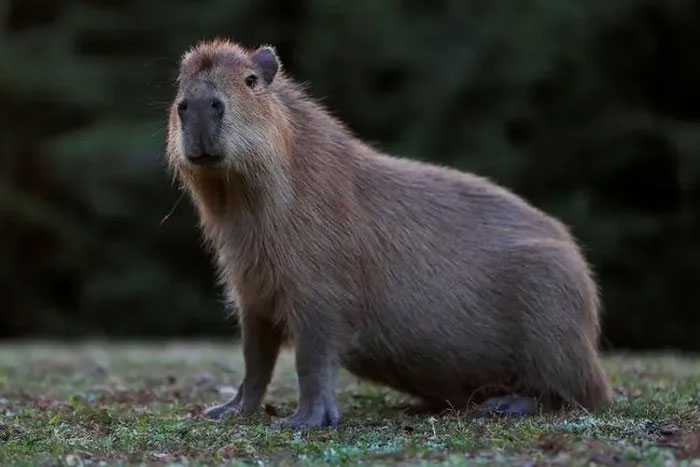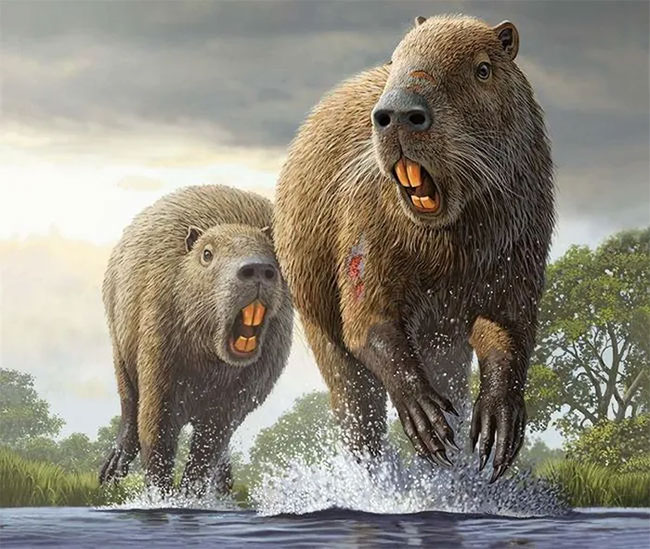The truth that makes the scientific world semi-credible: Prehistoric rats were as big as today's horses?
That is the conclusion reached in a recent study in the scientific journal Royal Society Open Science. Referring to mice, everyone immediately thinks of small rodents with "negligible" size and mass. For example, a dwarf mouse that weighs only 28g, or as big as a guinea pig (the world's largest rodent) will only weigh up to 79.4kg.

Image of a water guinea pig.
However, even today's largest water guinea pig is small compared to some prehistoric mice. Because according to research by scientists, prehistoric rodents have unexpectedly huge sizes, with an appearance like a hybrid between an oversized guinea pig and a hairy hippo.
According to the New York Times, paleontologists estimate that a Phoberomys pattersoni rat could weigh up to 590kg. Another species of rat is Josephoartigasia monesi weighing about 907kg, about the size of a bison.

The image simulates the size of Josephoartigasia monesi - a giant prehistoric mouse that once lived on Earth.
But predictions about the species' size have long sparked debate. Paleontologist Russell Engelman, from Case Western Reserve University, said: "People have said they were the size of bison, but nobody has any method that can confidently prove these. this size is real".
So Mr. Engelman proposed a new method to accurately describe the size of these unusually sized rodents.
In a study published Wednesday in the journal Royal Society Open Science, he calculated the size by comparing a joint at the back of the skulls of Phoberomys, Josephoartigasia rats and other species. Prehistoric rodents were different from today's large mammals.

Between 2 million and 8 million years ago, giant rodents such as Phoberomys and Josephoartigasia inhabited the swamps of South America.
According to Ernesto Blanco, a paleontologist at the Universidad de la República in Uruguay, who discovered the skull of a Josephoartiasia rat in 2008, this giant rodent has a bite so powerful it generates a folding force. 3 times the bite of a modern tiger. Thereby protecting them from predators such as birds and saber-toothed marsupials.
Much of our understanding of these rodents today revolves around their size.
"Body size is an important feature of mammals because everything you can't physically measure in fossils like ecology and physiology correlates with body size," said Virginie Millien, Zoologist at McGill University, who studies the body sizes of rodents and was not involved in the new study.
In 2010, Dr. Millien used fossils of females to estimate that Phoberomys was about the size of a large antelope.
Determining the exact size of these giant rodents is difficult. One reason is the lack of fossils.
Paleontologists have unearthed leg bones and other fragments from the Phoberomys rat skeleton, while Josephoartigasia only has a single skull to study.
With no fossil evidence, researchers often rely on anatomical samples of the extinct animal's closest living relative.
So Mr. Engelman used the condyle of the occipital bone, which connects the animal skull to the spine. This joint size varies very little in all mammals to ensure that the skull and spine are always attached. Therefore, this is the basis for comparing different animals.
Recently, Mr. Engelman sought to measure joint width in more than 400 species of mammals, including rats and African elephants.
From there, he discovered that the width of the condyle of the occipital bones was an accurate indicator of their size. Because joint widths in mammals of the same size are similar, Engelman was able to compare the joint sizes of prehistoric mice with those of other mammals.
As a result, he greatly reduced previous estimates by other researchers. Accordingly, the Phoberomys rat weighs a maximum of 204kg, while the Josephoartigasia species weighs about 454kg, close to the size of a horse, not a bison with a weight of nearly 1 ton.
- Ambition to create a race of asexual horses
- The world's most exclusive dwarf horse
- The wild horse Przewalski echoes the prairie
- View Tesla Semi trucks rolling first in the street
- Pile prehistoric houses around the Alps - Austria's world cultural heritage
- Interesting facts about horses
- Small horses like ... cats
- Interesting things of horses
- Why do horse legs have to nail iron?
- The horse can count
- The oldest horse in the world
- Wild horses
 Discovered an ancient centipede fossil 99 million years old
Discovered an ancient centipede fossil 99 million years old Discovered bat-like dinosaurs in China
Discovered bat-like dinosaurs in China Discovered a 200-year-old bronze cannon of the coast
Discovered a 200-year-old bronze cannon of the coast Discover 305 million-year-old spider fossils
Discover 305 million-year-old spider fossils New discovery in dogs points to paradox in nature
New discovery in dogs points to paradox in nature  The largest land mammal that ever lived was Paraceratherium - How big was it really?
The largest land mammal that ever lived was Paraceratherium - How big was it really?  List of sea snakes with extremely strong venom in Vietnam
List of sea snakes with extremely strong venom in Vietnam  Predatory 'king' of the Japanese sea: The body is 'big', dominating at a depth of 2,000 meters of water
Predatory 'king' of the Japanese sea: The body is 'big', dominating at a depth of 2,000 meters of water  The cutest little animals in the world
The cutest little animals in the world  6 tools to reduce online and offline videos
6 tools to reduce online and offline videos 